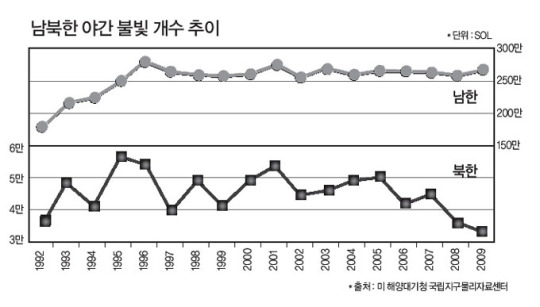Naver, the popular South Korean portal site, has an interesting article about using lights at night to measure economic growth. Three researchers at Brown University used imagery taken from 1992-2009 by U.S. Air Force weather satellites to develop a proxy for measuring GDP growth (or contraction) by measuring the amount of light visible at night from outer space. The idea being to get a better idea of GDP changes in countries, like North Korea, that don’t release or compile economic data. One of their images, contrasting brightly-lit South Korea with a dark North, was made famous by former Secretary of Defense McNamara Rumsfeld.

According to the study, the North’s economy has gone up and down quite a bit during the 18 years surveyed, with a large decrease in 1994 as the effects of the Soviet Union’s collapse took hold, only to rebound in 1995 to the highest level found in the survey. Lower levels reported from 1997 to 1999 match the period when hundreds of thousands are believed to have died of starvation in the North. With the successive South Korean administrations of Kim Dae-jung and Roh Mu-hyun, and their liberal aid policies, the numbers in the survey improved and stabilized from 2000 to 2005.

The two worst years reported are 2008 and 2009 (the latest year in the study), meaning current economic output in the North, as measured by the visible light study, has fallen to levels below those found at any time since the collapse of the Soviet Union. While hardly an exact measurement, the findings paint an unpleasant portrait of current trends in the North.
Given much greater resistance to aid provision this time around, in both South Korea and the international aid community, than in the crisis of the mid-90s, economic and social conditions in the North are looking exceedingly bleak. This could help explain the North’s current international begging spree, continued attempts to win Southern approval to restart the lucrative tours to Mt. Kumgang (the Diamond Mountains), willingness to meet with outsiders like President Carter, and apparent readiness to return to the 6-Party Talks in Beijing.
Not sure if I buy it all, but still an interesting take on economic development and changes in GDP. Have a look at the paper, or the raw NOAA info (for countries around the world, not just Korea) if you get a chance. The observed changes in Rwanda pre- and post-genocide (pg. 49 of the study) are especially eerie.